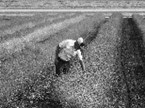Longer days, warm sun and vanishing snow are usually enough to make most horsemen start to give serious thought to their horses and now to prepare them for that first spring show, big spring trail ride or for just plain pleasure riding. Just as most motorists give their cars a spring tune-up, so do horsemen attempt to get their horses prepared for the busy season ahead. In the case of the horse, his preparation should have as its objectives not only the reconditioning of the horse but perhaps even more important the keeping of the horse sound and healthy for the entire season. The big questions are where to start and what to do.
The first step in tuning up the horse should be a treatment for internal parasites. Fecal samples supplied to a veterinarian will enable him to prescribe the proper treatment. Any parasite treatment should be accompanied by a through stable cleaning with the removal and disposal of all manure accumulated over the winter. Pastures and paddocks should also be cleaned and, if necessary, dragged with a harrow to break up all feces to expose all worm eggs to the sun and elements. If the level of infection acquired over the winter has been relatively high, the veterinarian very probably will suggest a second treatment approximately on month after the first. This can be particularly beneficial where young foals and yearlings are present since it helps to eliminate the reservoir of re-infection which can produce serious growth retardation in young horses.
Feet and legs are also in need of a great deal of care before any extensive riding is attempted. The hooves should be carefully trimmed and any signs of disease or injury treated. For horses that are going to be used extensively, shoes will be needed. The partially frozen, rough ground of early spring can be extremely damaging to horses’ feet. Since most early spring riders encounter a few accumulated snow banks and muddy conditions, the lets should be trimmed to the knees and hocks with all long hair removed. The legs should be very carefully groomed after every ride to eliminate any accumulation of mud or ice on the legs. The short hair will make this grooming job much easier. Manes and tails, likewise, should receive considerable attention. Be sure to thin manes gradually and long, full tails should be protected from mud and snow.
Most horses come out of the winter entirely too fat or the opposite- too thin. Unless the horse has been used routinely during the winter, the horse will also need a great deal of conditioning to gain muscle tone, wind and stamina. Regardless of the condition of the horse, he must now be fed according to use. A high protein diet (approximately 15%) coupled with a high energy intake will help the horse shed more quickly and reduce grooming time; however, any changes from the winter feeding programs should be instituted gradually, preferable over a period of at least two weeks. If the horse has acquired a “hay belly” it may be desirable to decrease the amount of hay being fed and to compensate by an increase in the grain concentrate portion of the ration. It is generally preferable to correct the over-fat condition by vigorous exercise rather than reduction of feed intake whereas the underfed horses will definitely have to receive a great deal more fed to put them into shape and to provide the energy to regain muscle tone.
Exercise is a very important aspect of any spring work with horses. The out-of condition horse will have to be brought along slowly at first. For the horse that has not been used during the winter and has been kept rather closely confined, exercise periods initially probably should not exceed 15 minutes. These may be increased by a few minutes each day as the horse begins to regain his muscle tone and wind. If stable facilities permit sufficient protection from chills, a horse should be allowed to work up a good sweat at each riding. This will serve to stimulate shedding and a healthy skin as well as to insure that a horse is being challenged and is making progress. The horse must be carefully groomed after each workout, walked until dry and, if necessary, blanketed. Special care should be taken particularly during the early stages of re-conditioning to note any indications of lameness or any areas of heat or tenderness in the legs. If such condition is noted, it is quite probable that the training program has been pushed too rapidly. The most important aspect of training is that it should be done daily, progressively and be aimed at reaching a desired condition by a specific date.
This article is an excerpt from a fact sheet by Dr. Samual Sabin



